Jul 13, 2018
Risqué Brand Tone on Social Media: Where to Draw the Line?
The noise on social media is increasing, and the potential reach for brands is actually declining – Facebook page posts only have around a 2% reach. Brands are now being forced to get more creative, and creativity can end up going many ways we couldn’t have imagined just a few years ago. Examples of witty, bold, clever, pun-driven social media posts are almost endless.
Here’s the thing though: taking this direction can either be incredibly successful or fail spectacularly. A well thought-out campaign can turn into a fully-fledged tone on social media, while a poorly executed one can damage the brand’s reputation long-term and deter even the most loyal fans.
In this article, we’ll dive into what makes up a brand’s voice, tone and image in the first place. Then, we’ll look into many examples, both good and bad, to inspire you and save you from repeating other companies’ mistakes.
Voice, Tone and Brand Image
While these might feel like just different names for the same thing, a brand’s voice, tone and image all represent a separate entity of their online presence.
Buffer sums up voice and tone as follows:
Voice: Your brand personality described in an adjective. For example, a brand can be lively, positive, professional or witty.
Tone: A subset of the above-defined brand’s voice. Tone adds specific flavor to your voice based on factors like audience, situation and channel.
On top of that, Management Study Guide defined brand image as the current view of the customers about a brand, a unique bundle of associations within the minds of target customers.
Essentially, your brand should have one voice and many tones that refine that voice depending on the occasion and platform. As a result of your activities, your audience will have a perceived image of your brand.
The lesson here is clear: when you decide to write your social media posts in a certain way, keep in mind that it goes beyond how you believe they will be perceived – your audience makes the ultimate judgement. Sprout Social published a study which shows that snarky and funny behavior from brands on social is desired and expected, but not prior to honesty, friendliness, and helpfulness:
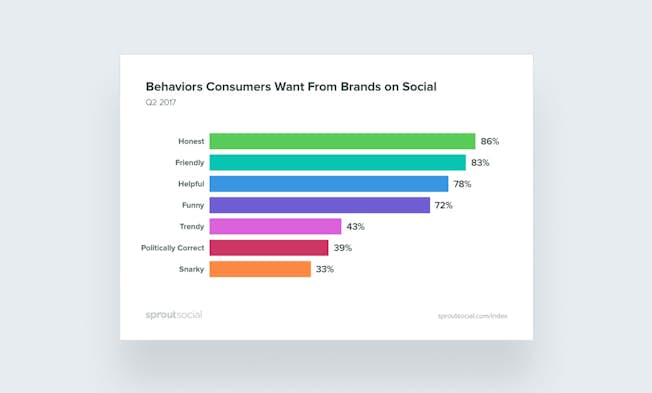
Let’s dive into the potential audience touchpoints on social media that play an important role in defining your voice and tone.
Where Do Your Tone and Brand Image Make an Impact?
Every point of interaction between you and your audience – points where you get to be professional, serious, snarky, bold, and many other things – can typically be sorted into one of the three categories on your social profiles.
Your social media ID: profile description, profile photo and header image
In most cases, profile imagery and descriptions are a place where companies describe what they do and showcase their logo, photos of their retail space and their team members. They typically use phrases such as “We help [audience] do [goal]”, or “Welcome to [company name] official Twitter page.” It’s a quite a standard and most frequent approach.
However, many companies across various industries use this space in a bolder way, often using their target audience’s phrases, puns and wordplay, wit and jokes to set potential followers’ expectations for the content they will see should they choose to follow.
Below is an example from Old Spice. It is so consistent with all their social media activity, and even their TV ads, that you can almost hear Terry Crews screaming at you as you read their Twitter bio.
Another example comes from Innocent Drinks, whose Twitter bio reflects their entire light-hearted, health-driven online presence, as well as their mission. It can also be a good idea to directly say what to expect from your particular social media profile, just like Paddy Power does.
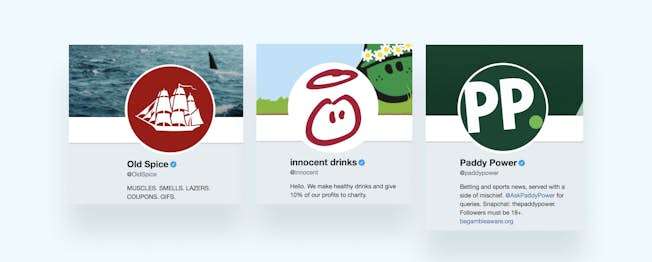
Public, planned posts
For most companies, the bulk of their social media existence is based on the posts they publish from their accounts to the general public. From plain text and photos through to videos, GIFs, links and polls, there is plenty of room to express your brand’s personality.
When it comes to planning these into the marketing calendar and scheduling them, the majority play it safe. They post about their ongoing offers, customer reviews and new products. They adjust their posts to the season of the year, relevant news, or anything else that they know their customer would be talking about.
And then there are the risk-takers. When you see these daring posts in your feed, you almost always want to look at people’s reactions. They can vary from hilarious to straight-up shocking, and brands who excel at this never seem to lack ideas for more.
One example comes from Steak-umm, which, unsurprisingly, sells steak products. This is the look and feel of their Twitter feed on a daily basis:
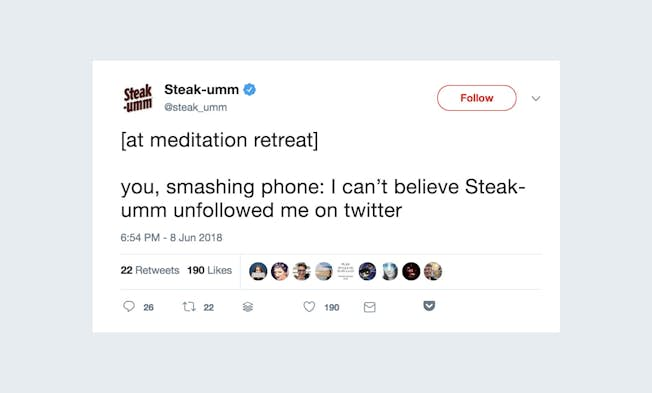
Another example comes from The Hustle, a tech and business newsletter that’s quite popular with their #showerthoughts:
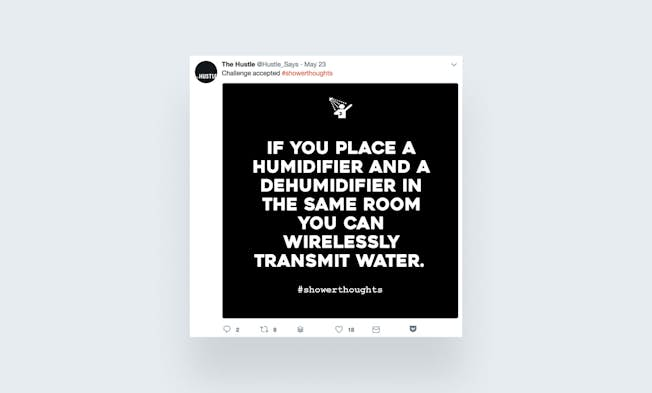
Interactions
The third place is in your comments, replies and any other interactions with your audience or with other brands. As you’ll see in further examples later on, this is often the most fertile ground for exchanges that turn viral and reach a broader audience than a regular post ever would.
It can be risky to talk to others in such a public space without potentially offending someone directly. It is always a human being at the other end of that conversation, so taking the creative path in replying to others may result in a raving fan or a lifelong nemesis.
Pop-Tarts doesn’t hide from the fact that their products may be faulty, and they reply to complaints in wonderfully honest and amusing ways:
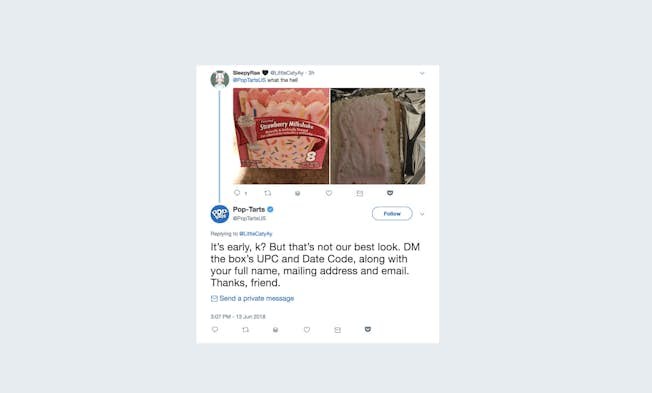
As a final example of this, it’s impossible not to mention Wendy’s. They have a reputation for roasting both their competitors and everyday people who tweet at them. It’s positively accepted, and they don’t look like giving up anytime soon:
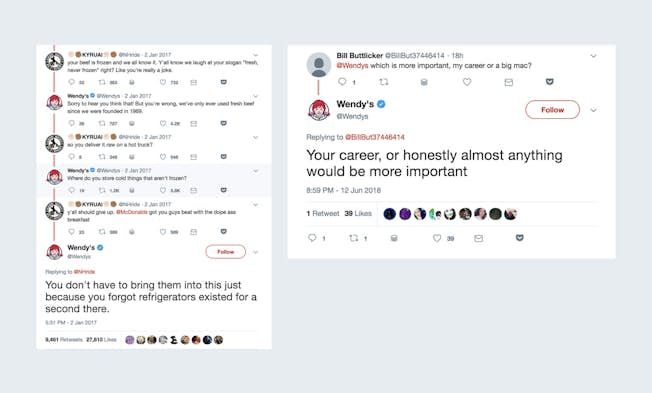
What Can You Learn from the Best and Worst Examples?
Some of the examples so far probably gave you a solid idea of a whole spectrum of options when it comes to testing the limits of your tone on social media. Some examples mentioned so far have been mild and chuckle-worthy, but as you’ll see in this section, things can escalate pretty quickly, even from a single post, and results end up being spectacularly great or remarkably awful for the brand.
Risqué content is typically humorous, snarky, clever, witty, cynical, and potentially many other things – and most often a mix of a few of these. However, there’s a common theme in all of this: aiming to trigger a strong emotion and an intense reaction. The usual rule is: the deeper this aim, the fiercer the reaction, either positive or negative.
Let’s dive into some more examples from both sides and identify a few lessons every brand can learn from them. One of the most important elements to keep in mind is the immediate context for the intended recipients – the target audience. Their existing relationship with the brand, and the tone they’re used to, plays an essential role in this.
Just think of it like this: you probably aren’t expecting the same serious and professional tone from your life insurance provider and the pub down the street. Let’s look at some common denominators for quirky brand activities on social media.
Leveraging trends, seasons and news
Being current means being relevant, which Lidl knows and implements regularly, like in this tweet when Ireland was stuck under snow in February:
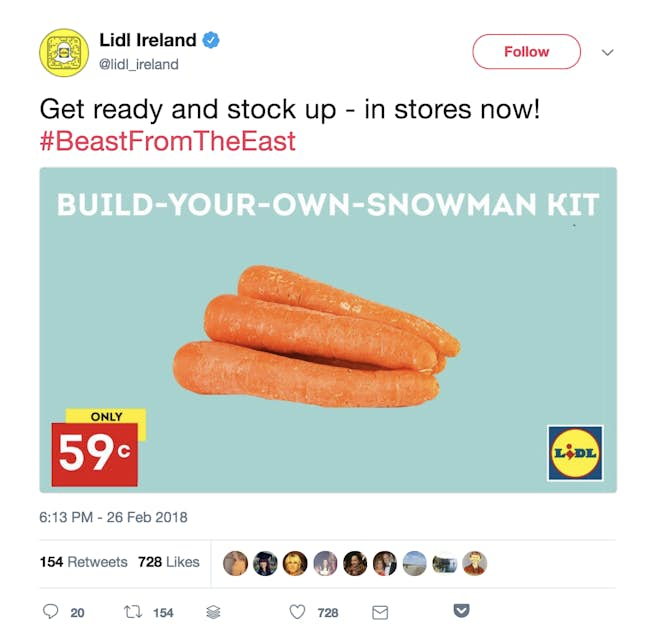
Creative agency R/GA reacts to news and current topics daily, and is not afraid to mention politics and provocative topics. The reactions they spark are overwhelmingly positive.

Sadly, hopping on trending topics doesn’t always turn out great for brands. One of the most frequently frowned upon action is piggybacking on the death of a celebrity or a disaster of any kind. Cheerios made this mistake with Prince’s death, and Kenneth Cole slipped up at the time of a military coup in Cairo. Both tweets have been deleted soon after, but their screenshots are still available:
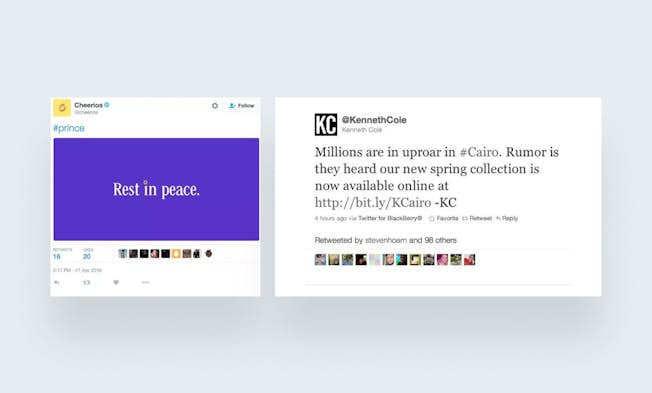
Alluding to or enticing age-restricted behavior
Unless your brand exclusively talks about adult-only topics such as gambling, drinking and sex, the safest thing is probably to steer clear from them. Brands with a wide enough reach for their social posts to catch fire almost definitely have minors in their audience. They risk the anger of protective parents, teachers or simply any common-sense grown-up audience when they take this route.
Ryanair recently regretted a campaign for students who were about to graduate from high school. People complained that they were encouraging binge-drinking, and the post was then removed:

Joking on someone else’s account
Finally, the most frequent path with edgy social tone – and the one that most easily catches fire quickly – involves interacting with other accounts and taking advantage of something they did or said. It seems like brands do this to prove they are a level above, cleverer and witty.
One of the most extraordinary recent examples of this, and the one with a tremendous reach, is the chain reaction to IHOP’s recent temporary rebrand to IHOb which aimed to push the sales of their burgers.
The amount of PR they received was beyond measure, with reactions from Burger King, Netflix, Timehop, and Whataburger:
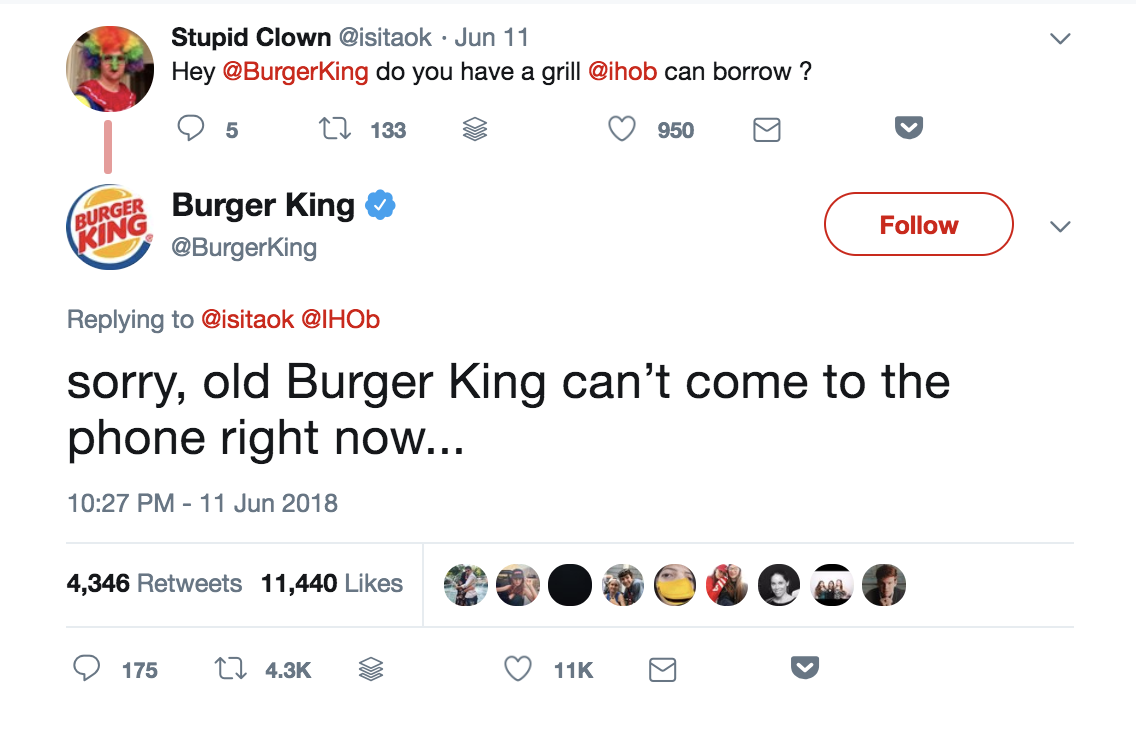
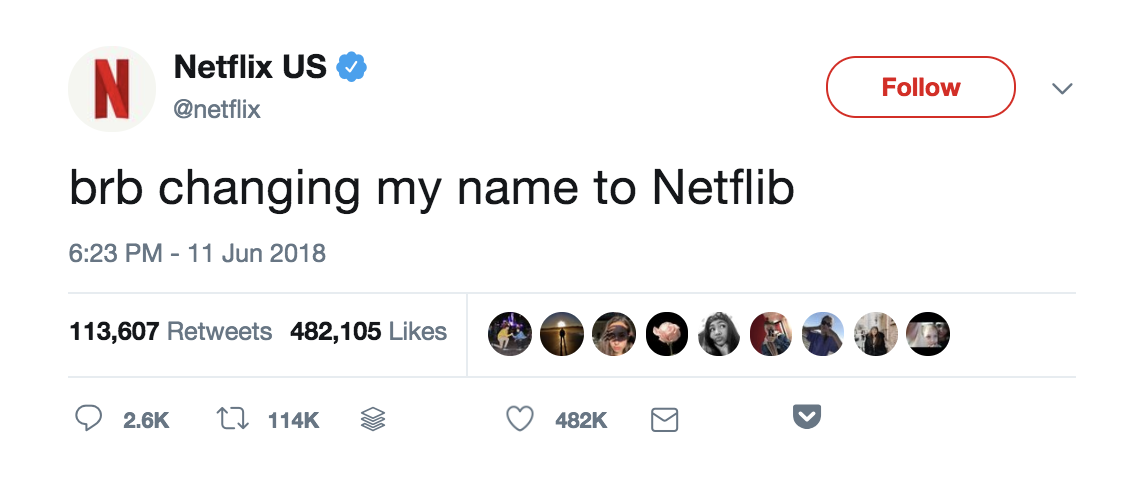
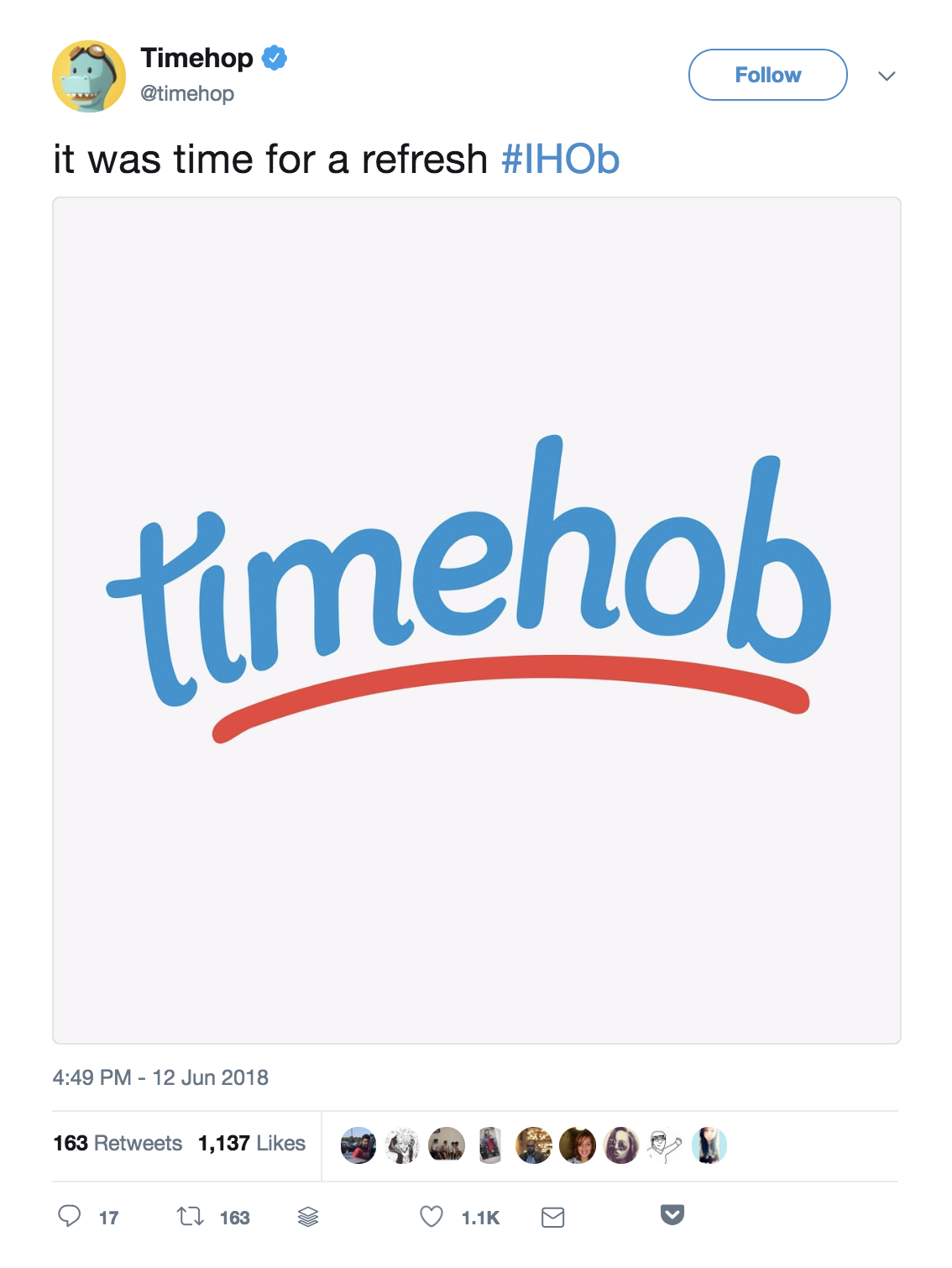
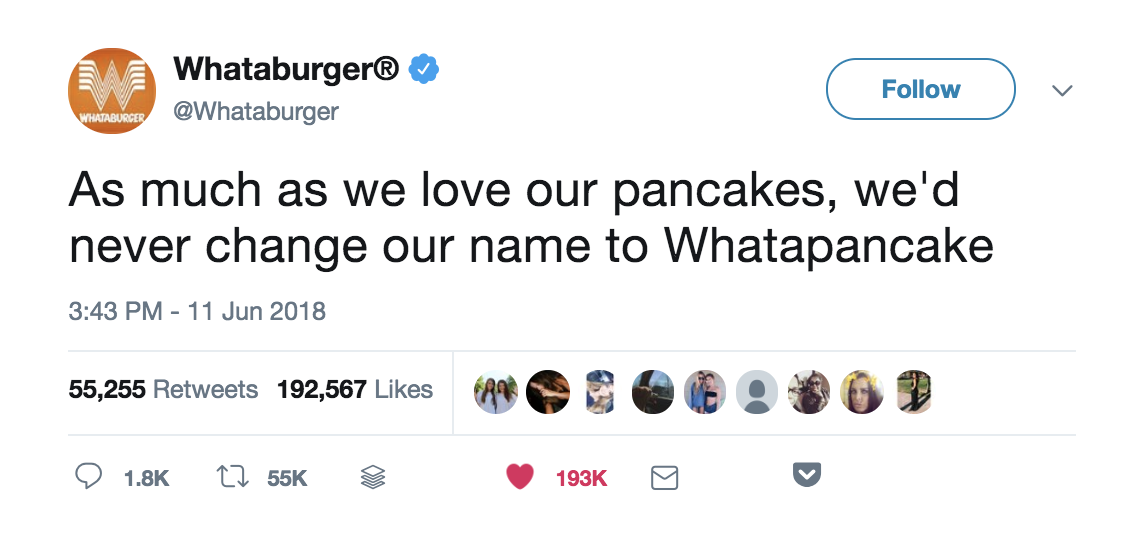
These posts largely represented the existing tones of these accounts, and the reactions of their respective audiences were incredibly positive.
Old Spice reacts to silly tweets with, well, silly tweets, and just like everything else with their social media tone, it works:
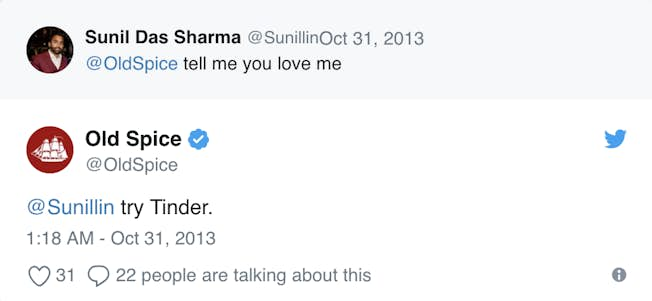
The negative example for this section is a rather spectacular one. This seemed like an innocent exchange between a frustrated Thameslink traveler and Thameslink’s customer service representative...
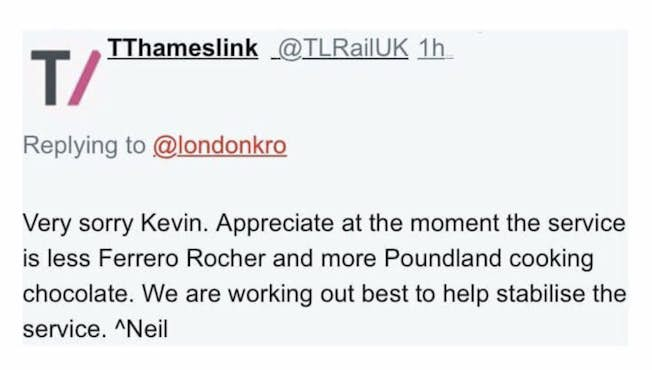
This ended up being a full-blown social media spectacle:
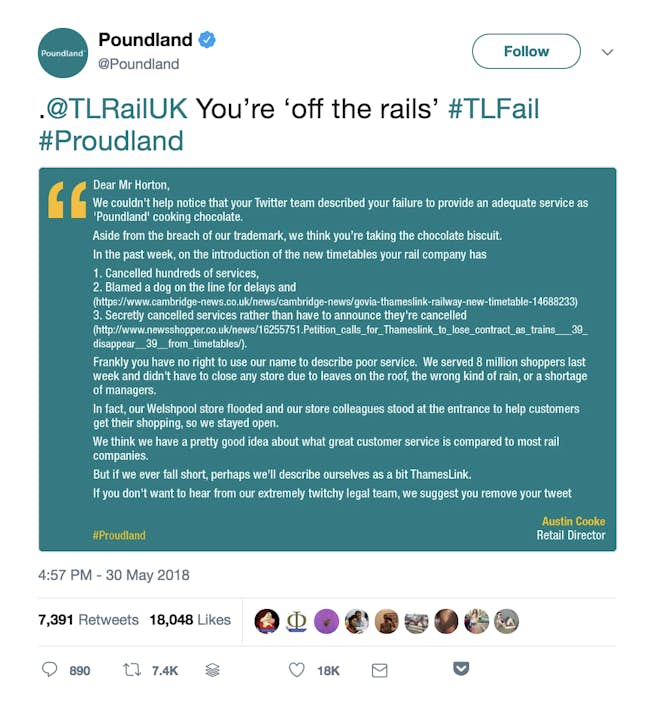
How Can You Take Action (And Not Mess Up)?
We’ve covered a lot – the good and the bad, the mild and the huge, the logical and the peculiar. This space is impactful beyond words, and it’s difficult to boil it down to a few universally applicable takeaways that you can implement and end up with a quirky, popular social media presence.
That’s because there is no magic formula or a tried and trusted recipe. As you have seen, different tones work with different audiences. Would the mildly offensive tone Wendy’s use work for Innocent’s audience? Probably not. Would it work vice versa? Maybe, but then we wouldn’t know Wendy’s as a bold and courageous brand online.
All these brands have something in common: they’ve done something brave in a public space that is quick to judge and where nothing can go unnoticed. Some of them have done it once and have likely given up because it went terribly wrong. Others have been going at it for years and have created a recognizable riskiness to their tone which everyone now knows them for.
The ultimate takeaway is this: there is always space to test and explore your tone, but it’s crucial to do it slowly and with great care. Things aren’t universally funny and not everything is obvious, and if you want to become more audacious on social media, you should take it one toned-down audacious step at a time.
Here are some things you can try:
- When you want to share something you find funny, like tweeting a joke, sharing a pun, or making fun of someone, take it to 5-10 people first. Try to talk to these people individually (not in a group) and simply gauge their initial reactions. If your idea is good, you will get a positive response from all of them. If not, go back to the drawing board.
- When you experiment with something new, follow your audience’s real-time reactions. This will help you not only measure the success of your post, but also react as quickly as possible in case you need damage control.
- Create guidelines, a file with examples (both bad and good), and keep educating company staff both in and outside the social media team.
With these examples and tips in mind, you will now see social media in a slightly different light – hopefully helping you and your brand to shine in a way that makes your perfect audience feel exactly the way you hope them to.
Upgrade to Power Membership to continue
your access to thousands of articles, toolkits, podcasts, lessons and much much more.
Become a Power Member- Login
- View Courses
- - - -
- Courses
- Resources
- - - -
- My Account
- Change Password
- Logout





